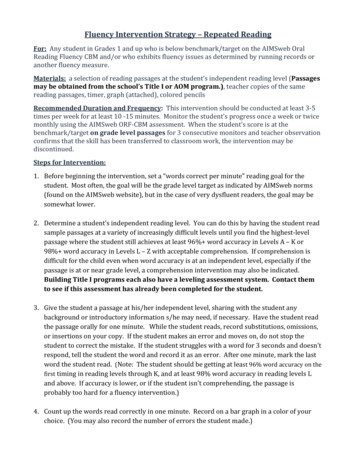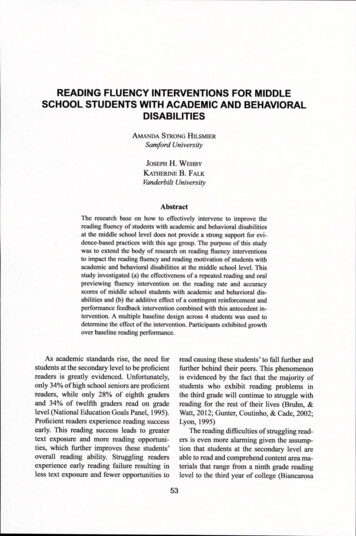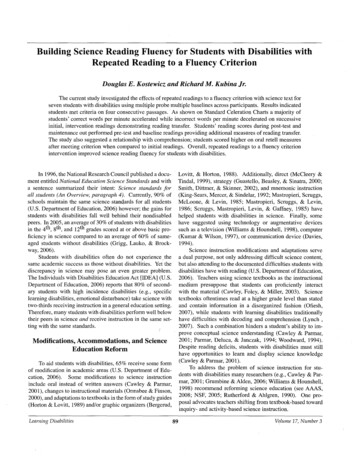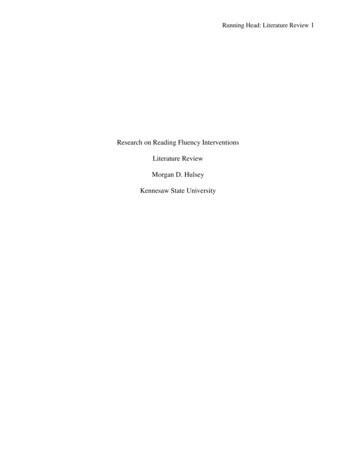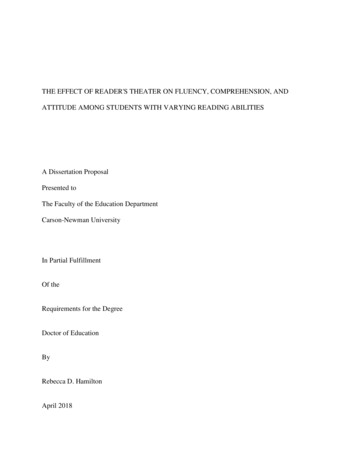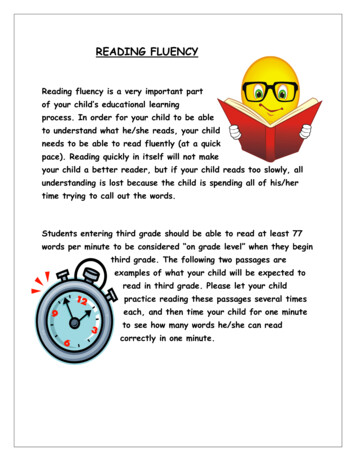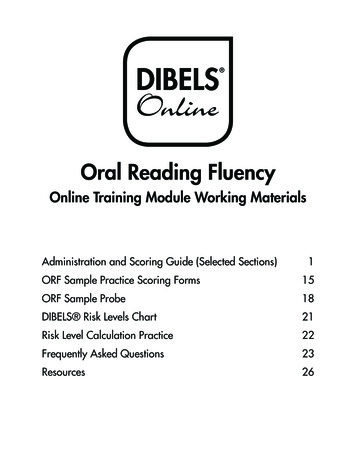
Transcription
Oral Reading FluencyOnline Training Module Working MaterialsAdministration and Scoring Guide (Selected Sections)1ORF Sample Practice Scoring Forms15ORF Sample Probe18DIBELS Risk Levels Chart21Risk Level Calculation Practice22Frequently Asked Questions23Resources26
Dynamic Indicators of BasicEarly Literacy SkillsTM 6th EditionDIBELSTMDIBELS Oral Reading FluencyDIBELS Retell FluencyDIBELS Nonsense Word FluencyDIBELS Phoneme Segmentation FluencyDIBELS Letter Naming FluencyDIBELS Initial Sound FluencyDIBELS Word Use idEndBegFirst GradeMidEndSecond GradeBegMidEndThird GradeAdministration and Scoring GuideEdited By:Roland H. Good IIIRuth A. KaminskiUniversity of OregonAvailable:http://dibels.uoregon.edu/Good, R. H., & Kaminski, R. A. (Eds.). (2002). Dynamic Indicators of Basic EarlyLiteracy Skills (6th ed.). Eugene, OR: Institute for the Development of Educational Achievement.Available: http://dibels.uoregon.edu/. 2002 Dynamic Measurement Group, Inc.Revised: 07/02/031
DIBELSTMPage 2Dynamic Indicators of Basic Early Literacy Skills (DIBELS) 6th EditionEdited byRoland H. Good III & Ruth A. KaminskiUniversity of OregonPublished byInstitute for the Development of Educational AchievementUniversity of OregonCONTENTSLetter Naming Fluency.Ruth A. Kaminski and Roland H. Good III6Initial Sound Fluency.Roland H. Good III, Deborah Laimon, Ruth A. Kaminski, and Sylvia Smith10Phoneme Segmentation Fluency.Roland H. Good III, Ruth Kaminski, and Sylvia Smith16Nonsense Word Fluency .Roland H. Good III and Ruth A. Kaminski23DIBELS Oral Reading Fluency and Retell Fluency .Roland H. Good III, Ruth A. Kaminski, and Sheila Dill30Word Use Fluency.Roland H. Good III, Ruth A. Kaminski, and Sylvia Smith39DIBELS Approved Accommodations .Roland H. Good III and Ruth A. Kaminski44DIBELS Instructional Recommendations: Intensive, Strategic, and Benchmark .Roland H. Good III, Deb Simmons, Ed Kame’enui,Ruth A. Kaminski, and Josh Wallin48References.67 2002 Dynamic Measurement Group, Inc.2
DIBELSTMPage 3AcknowledgementsSupported byEarly Childhood Research Institute on Measuring Growth and DevelopmentU.S. Department of Education (H024360010)Institute for the Development of Educational Achievement, University of OregonThe authors acknowledge with appreciation the assistance of Deb Simmons, EdKame’enui, John Bratten, Debby Laimon, Karen Rush, Mark Shinn, MichelleShinn, Sylvia Smith, Ilsa Schwarz, Scott Baker, Shaheen Chowdri, CheriCornachione, Patricia Coyne, Shanna Davis, Kathleen Fleming, Jerry Gruba, LisaHabedank Stewart, Beth Harn, Kathrine Kohler, Elida Lopez, Dawn SheldonJohnson, Stephanie Vincent, Janet Otterstedt, Debbie Johnson, Ambre ReMillard,David VanLoo, Hank Fien, Diane Hill, Rachel Katz, Jennifer Knutson, PamelaRaya-Carlton, Catherine Doyle, Susan Stephani, Nancy Bank, Chantal DufourMartel, Jennifer Jeffrey, Katy Kimer, and Carol StockLetter Naming FluencyRuth A. Kaminski and Roland H. Good IIIBased on previous research by Marston and Magnusson (1988). Supported by the U.S.Department of Education grant H023B90057.Initial Sound FluencyRoland H. Good III, Deborah Laimon, Ruth A. Kaminski, and Sylvia SmithBased on Onset Recognition Fluency by Deborah Laimon and Roland Good. The authorsacknowledge with appreciation the assistance of Melissa Finch, John Bratten, Nancy Bank,Ambre ReMillard, Diane Hill, Hank Fien, David VanLoo, Rachell Katz, Scott Baker, StephanieVincent, Lisa Habedank Stewart, and Marty Ikeda. Supported by Student-Initiated Grant(90CD0819) funded by the U. S. Department of Education, Special Education Programs.Phoneme Segmentation FluencyRoland H. Good III, Ruth Kaminski, and Sylvia SmithBased on a prior version of Phoneme Segmentation Fluency by Ruth Kaminski and RolandGood. The authors acknowledge with appreciation the assistance of Lisa Habedank, DawnSheldon Johnson, Scott Baker, Debby Laimon, Marty Ikeda, and others. Also supported by theU. S. Department of Education grant H023B90057.Nonsense Word FluencyRoland H. Good III and Ruth A. KaminskiThe authors acknowledge with appreciation the assistance of Sylvia Smith, Mary GleasonRicker, Katherine Koehler.DIBELS Oral Reading FluencyRoland H. Good III, Ruth A. Kaminski, and Sheila DillBased on the work on Curriculum-Based Measurement by Stan Deno and colleagues through theInstitute for Research on Learning Disabilities, University of Minnesota. The authors 2002 Dynamic Measurement Group, Inc.3
DIBELSTMPage 4acknowledge with appreciation the assistance of Sylvia Smith, Nancy Bank, Chantal DufourMartel, Adeena Sarah and data collectors.Word Use FluencyRoland H. Good III, Ruth A. Kaminski, and Sylvia SmithThe authors acknowledge with appreciation the assistance of Rachel Katz, Jennifer Jeffrey, KatyKimer, Jennifer Knutson, and Carol Stock. 2002 Dynamic Measurement Group, Inc.4
DIBELSTMPage 5Educational Use AgreementDIBELSTM is a proprietary name referring to the work of Roland Good, Ruth Kaminski,and select colleagues (Dynamic Measurement Group, Inc., DMG). The intent of DMG is to makethe DIBELS assessment tools available to the educational entities listed below. Such use,however, is not intended to and does not place the materials in the public domain. Photocopymasters of the materials are available at (dibels.uoregon.edu). Schools, school districts andmulti-district agencies may make unlimited photocopies of these materials for internaleducational use. In addition, Sopris West publishes a print version of the measures(www.sopriswest.com), and Wireless Generation provides a Palm application (www.wgen.net).These materials may not be resold on a for-profit basis without the express written consent ofDMG and Sopris West. As a part of our program to provide the free photocopy masters andpermission to photocopy described above, we do require all users to register on the website sothat we may document usage as we pursue additional research and development funding, and sothat we may notify users when new and improved materials are available. We also require thatusers copy the DIBELS materials without modification except as agreed to in advance and inwriting by DMG. Modifications that would be agreed to include changing color or font ofmaterials. Modifications that would not be permitted include removing logos oracknowledgements for contributions to the DIBELS materials. Any uses of our DIBELSmaterials that are inconsistent with the provisions of this Educational Use Agreement are strictlyprohibited. 2002 Dynamic Measurement Group, Inc.5
DIBELSTM Oral Reading Fluency1Dynamic Indicators of Basic Early Literacy SkillsTM 5th Ed.University of OregonDirections for Administration and ScoringTarget Age RangeDIBELS Oral Reading idFirst GradeEndBegMidEndSecond GradeBegMidEndThird GradeOral Reading Fluency is intended for most children from mid first grade through thirdgrade. The benchmark goals are 40 in spring of kindergarten, 90 in spring of second grade, and110 in the spring of third grade. Students may need intensive instructional support if they scorebelow 10 in spring of first grade, 50 in spring of second grade, and 70 in spring of third grade.DescriptionDIBELSTM Oral Reading Fluency (DORF) is a standardized, individually administeredtest of accuracy and fluency with connected text. The DORF passages and procedures are basedon the program of research and development of Curriculum-Based Measurement of reading byStan Deno and colleagues at the University of Minnesota and using the procedures described inShinn (1989). A version of CBM Reading also has been published as The Test of ReadingFluency (TORF) (Children’s Educational Services, 1987). DORF is a standardized set ofpassages and administration procedures designed to (a) identify children who may needadditional instructional support, and (b) monitor progress toward instructional goals. Thepassages are calibrated for the goal level of reading for each grade level. Student performance ismeasured by having students read a passage aloud for one minute. Words omitted, substituted,and hesitations of more than three seconds are scored as errors. Words self-corrected within threeseconds are scored as accurate. The number of correct words per minute from the passage is theoral reading fluency rate.A series of studies has confirmed the technical adequacy of CBM Reading. Test-retestreliabilities for elementary students ranged from .92 to .97; alternate-form reliability of differentreading passages drawn from the same level ranged from .89 to .94 (Tindal, Marston, & Deno,1983). Criterion-related validity studied in eight separate studies in the 1980s reportedcoefficients ranging from .52 - .91 (Good & Jefferson, 1998).Materials: Student copy of passage; examiner copy, clipboard, stopwatch; colored scoring pen.Directions for Administration1. Place the reading passage in front of the student.Good, R. H., & Kaminski, R. A., & Dill, S. (2001). DIBELS Oral Reading Fluency. In R. H. Good & R. A.Kaminski (Eds.), Dynamic Indicators of Basic Early Literacy Skills (5th ed.). Eugene, OR: Institute for theDevelopment of Educational Achievement. Available: http://dibels.uoregon.edu/. 2001 Good & Kaminski6Revised: 7/28/01
DIBELSTM – ORFPage 302. Place the examiner copy on clipboard and position so that the student cannot see what yourecord.3. Say these specific directions to the student:When I say begin start reading aloud at the top of the page (point). Readacross the page (point). Try to read each word. If you come to a word youdon’t know, I’ll tell it to you. Be sure to do your best reading. Ready,begin.4. Start your stopwatch when the student says the first word of the passage. The title is notcounted. If the student fails to say the first word after 3 seconds, tell them the word and markit as incorrect, then start your stopwatch.5. Follow along on the examiner copy of the probe. Put a slash (incorrectly.) over words read6. The maximum time for each word is 3 seconds. If the student does not provide the wordwithin 3 seconds, say the word and mark the word as incorrect.7. At the end of 1 minute, place a bracket ( ] ) after the last word provided by the studentand say “Stop.” Record the total number of words read correctly on the bottom of thescoring sheet.8. Score reading passages immediately after administration.Directions for Scoring1. Discontinue Rule. If the student does not read any words correctly in the first row,discontinue the task and record a score of 0.2. Hesitate or struggle with words. If a student hesitates or struggles with a word for 3 seconds,tell the student the word and mark the word as incorrect. If necessary, indicate for thestudent to continue with the next word.Correct WordsPassageStudent SaysScoring Procedure/ Total WordsI have a goldfish.“I have a (3 seconds)” I have a goldfish.3 /43. Hyphenated words. Hyphenated words count as two words if both parts can stand alone asindividual words. Hyphenated words count as one word if either part cannot stand alone asan individual word.Number ofPassageWordsI gave Ben a red yo-yo.6We did push-ups, pull-ups, and sit-ups.9 2001 Good & Kaminski7
DIBELSTM – ORFPage 314. Numerals. Numerals must be read correctly in the context of the sentence.Correct Words/ Total Words4 /4PassageMy father is 36.Student Says“My father is thirty-six.”Scoring ProcedureMy father is 36.My father is 36.“My father is three six.”My father is 36.3 /4I am 6 years old.“I am six years old.”I am 6 years old.5 /55. Mispronounced words. A word is scored as correct if it is pronounced correctly in thecontext of the sentence. If the word is mispronounced in the context, it is scored as an error.Correct WordsPassageStudent SaysScoring Procedure/ Total WordsDad read the paper.“Dad reed the paper.”Dad read the paper.3 /4(i.e., long e)I ate too much.“I eat too much.”I ate too much.3 /46. Self Corrections. A word is scored as correct if it is initially mispronounced but the studentself corrects within 3 seconds. Mark SC above the word and score as correct.Correct WordsPassageStudent SaysScoring Procedure/ Total WordsSCDad read the paper.“Dad reed red theDad read the paper.4 /4paper.” (i.e., selfcorrects to short e)7. Repeated Words. Words that are repeated are not scored as incorrect and are ignored inscoring.Correct WordsPassageStudent SaysScoring Procedure/ Total WordsI have a goldfish.“I have a I have aI have a goldfish.4 /4goldfish.”8. Articulation and dialect. The student is not penalized for imperfect pronunciation due todialect, articulation, or second language interference. For example, if the student consistentlysays /th/ for /s/, and reads “rest” as “retht,” he or she should be given credit for a correctword. This is a professional judgment and should be based on the student’s responses andany prior knowledge of his/her speech patterns.Correct WordsPassageStudent SaysScoring Procedure/ Total WordsIt is time for a rest.“It is time for a retht.”It is time for a rest.6 /6(articulation)We took the short cut. “We took the shot cut.”We took the short cut.(dialect) 2001 Good & Kaminski85 /5
DIBELSTM – ORFPage 329. Inserted words. Inserted words are ignored and not counted as errors. The student also doesnot get additional credit for inserted words. If the student frequently inserts extra words, notethe pattern at the bottom of the scoring page.Correct WordsPassageStudent SaysScoring Procedure/ Total WordsIt is time for a rest. “It is time for a long rest.” It is time for a rest.6 /6I ate too much.“I ate way too much.”I ate too much.4 /410. Omitted words. Omitted words are scored as incorrect.PassageIt is time for a rest.Student Says“It is time for rest.”Scoring ProcedureIt is time for a rest.I ate too much.“I ate much.”I ate too much.Correct Words/ Total Words5 /63 /411. Word Order. All words that are read correctly but in the wrong order are scored as incorrect.Correct WordsPassageStudent SaysScoring Procedure/ Total WordsThe ice cream man “The cream ice manThe ice cream man3 /5comes.comes.”comes.I ate too much.“I too ate much.”I ate too much.2 /412. Abbreviations. Abbreviations should be read in the way you would normally pronounce theabbreviation in conversation. For example, TV could be read as “teevee” or “television” butMr. would be read as “mister.”Correct WordsPassageStudent SaysScoring Procedure/ Total WordsMay I watch TV?“May I watch teevee?”May I watch TV?4 /4May I watch TV?“May I watch television?” May I watch TV?4 /4My teacher is Mr.“My teacher is misterMy teacher is Mr.Smith.Smith.”Smith.My teacher is Mr.“My teacher is ‘m’ ‘r’My teacher is Mr.Smith.Smith.”Smith.5 /54 /5 2001 Good & Kaminski9
DIBELS Oral Reading Fluency — Assessment Integrity Checklist NeedsPracticeFineDirections: As the observer, please observe setup and directions, time and score the test with the examiner,check examiner’s accuracy in following procedures, and decide if examiner passes or needs more practice.Check box to indicate Fine or Needs Practice1. Performs standardized directions verbatim:When I say, “begin,” start reading aloud at the top of the page. Read acrossthe page. Try to read each word. If you come to a word you don’t know,I’ll tell it to you. Be sure to do your best reading. Ready, begin.2. Holds clipboard and stopwatch so student cannot see what he/she records.3. Starts stopwatch after student says the first word of the passage.4. For first word, waits 3 seconds for student to read the word. After3 seconds, says the correct word, starts the stopwatch, and scoresthe first word as incorrect.5. For all words, if student hesitates or struggles with a word for 3seconds, says the correct word and scores the word as incorrect.6. Puts a slash through words read incorrectly.7. Follows discontinue rule if student does not get any words correctin first line of text.8. At the end of 1 minute, places a bracket (]) after the last wordprovided and says “stop.”9. Records the number of correct words.10. Shadow score with the examiner. Is he/she within 2 points on thefinal score?10
DIBELS Approved Accommodations Good, R. H., & Kaminski, R. A.Dynamic Indicators of Basic Early Literacy Skills, 6th EditionAdministration and Scoring Guide (2002)Institute for the Development of Educational AchievementEugene, OregonAvailable: http://dibels.uoregon.edu/The purpose of accommodations is to facilitate assessment for children for whom a standard administrationmay not provide an accurate estimate of their skills in the core early literacy skill areas. Assessment andaccommodations to assessment should be consistent with the primary goal of accurately estimating the child’sskills in phonemic awareness, phonics or alphabetic principle, accuracy and fluency with connected text,reading comprehension, and vocabulary development.DIBELS approved accommodations are accommodations that are unlikely to change substantially themeaning or interpretation of scores on the measures or the target skill being assessed by the measure. WhenDIBELS approved accommodations are used, the regular DIBELS interpretation guidelines apply, andthe scores can be entered into the DIBELS Data System for reporting and interpretation. The “Tested withDIBELS Approved Accommodations” box should be checked in the student demographics section (note:Florida Reading First schools will not be using the DIBELS data system. Scores will be entered into theFCRR Progress Monitoring and Reporting Network).When the DIBELS assessments are administered in ways different from both a DIBELS standardadministration and the DIBELS approved accommodations, the administration would be considered anonstandard administration and the resulting scores cannot be interpreted with the DIBELS interpretiveand reporting procedures. Scores from a nonstandard administration using unapproved accommodationsshould not be entered into the DIBELS Data System for reporting and analysis. For example, extendedtime or un-timed administration would not be a DIBELS Approved Accommodation. For the DIBELS measures, fluency is an integral aspect of the construct being assessed. Scores from an un-timedadministration would not be comparable or interpretable with the procedures for reporting and interpretingDIBELS scores.An interventionist may elect to administer the DIBELS in an un-timed way, but the scores should notbe entered into the DIBELS Data System, the reliability and validity data for DIBELS would not beapplicable, and the benchmark goals would not be relevant or appropriate.Changes in Test Administration and Scoring that are Not ApprovedAccommodationsTiming. Changes in the timing of DIBELS assessments or un-timed administrations are not approvedaccommodations. If the DIBELS measures are administered under un-timed conditions or with extendedtime, the scores should not be entered into the DIBELS Data System. In addition, the research establishingthe reliability and validity of the measures would not apply to un-timed or extended time administrations. Inaddition, the scoring guidelines for interpreting level of risk and for making instructional recommendationswould not apply.11
Approved Accommodations for Retestingand Test-Teach-TestISFPSFA powerful accommodation for students who experiencea variety of difficulties is to repeat the assessment underdifferent conditions or with different testers. Retestingshould take place on different days with different probesunder different conditions that are considered to potentiallyimpact student performance. The median of the three mostrecent assessments should be used as the best indicator ofthe student’s skills.XXXResponse to instruction is a second, powerfulaccommodation for students who experience a varietyof difficulties. Repeated assessment on different dayswith different probes in the context of explicit instructionon the target skills. The target skills are phonemicawareness, phonics, and accuracy and fluency withtext. The target skills should be explicitly taught; underno conditions should the specific items on a probe beexplicitly taught. The median of the three most recentassessments should be used as the best indicator of thestudent’s skills.XXXISFPSFThe student may be tested in an alternate setting. Forexample, a special room with minimal distractions,complete quiet, or enhanced or specialized lighting.XXXThe student may be tested with a familiar person,interpreter, specialist, or other facilitator present. Thefamiliar person or interpreter may assist in supporting thestudent and the tester to obtain an accurate estimate ofthe student’s skills.XXThe student may be tested by a tester who is familiar withthe student’s language and communicative strategies andwith whom the student is comfortable. For example, thestudent’s teacher, or an aide especially familiar to thestudent, or even the student’s parent. In all cases, thetester must receive appropriate training, observation, andsupervision.XThe student may be tested by a professional with relevantspecialized training. For example, a student with severearticulation difficulty might be tested by a SpeechLanguage Pathologist. In this case, appropriate trainingis essential.XApproved Accommodationsfor Setting and Tester12NWF DORFLNFWUFXXXXXXLNFWUFXXXXXXXXXXXXXXXXXNWF DORF
Approved Accommodationsfor DirectionsISFPSFThe practice item may be repeated or one additionalexample may be provided.XXXIf necessary, the child can be provided with a leadexample in addition to the model example. “The sounds in‘sam’ are /s/ /a/ /m/. Do it with me, /s/ /a/ /m/.”XXXThe student’s understanding of directions can bechecked. For example, the student can be asked torepeat or summarize the directions.XXXXXXThe directions can be provided in a manner moreaccessible to the student. For example, directions canbe provided in sign language for a student who wouldbe more comfortable with sign than verbal directions.A student with limited English proficiency may beprovided with the directions in their primary language.For example, to assess a student’s early literacy skillsin English, directions for the task may be provided inSpanish and stimulus items presented in English.XXXXXXISFPSFLNFWUFApproved Accommodationsfor Stimulus MaterialsNWF DORFLNFXNWF DORFLarge print or an enlarged edition of stimulus materialsmay be used.XXXXClosed-circuit TV for enlargement of print andpicture stimuli is appropriate if necessary to enhanceperformance for students with low vision.XXXXColored overlays, filters, or lighting is appropriate ifvision and performance is enhanced.XXXXIf a student has sufficient skills with Braille, a Brailleedition of stimulus materials may be used. A Brailleedition of materials is being developed. Scores for theBraille edition may not be directly comparable to thenon-Braille edition.XXXAn alternate typeface for stimulus materials may beused. For example, a frequently encountered typefacefor most print and reading materials used in first andsecond grade is a ‘Times’ typeface. The target of anytypeface is one that would be used in reading materialin first grade.XXXStimulus materials may be printed in color for ease ofidentification and use.WUFX13
Approved Accommodationsfor Stimulus Materials (continued)PSFAlternate pictures of the target words may be usedif pictures that are more familiar to the student areavailable. The target word should not be changed.XIf the words in the Initial Sound Fluency are unfamiliarvocabulary for the student, the student can be askedto repeat the words associated with each picture. Forexample, “This is ‘mouse.’ What is this? This is ‘flowers.’What is this? This is ‘pillow.’ What is this? This is‘letters.’ What is this?”XIf the words used in the Initial Sound Fluency areunfamiliar vocabulary for the student, the vocabularycan be taught prior to the administration of the measure.The words selected for the ISF measure are drawn fromwritten materials appropriate for first and second gradestudents, so students can be expected to encounter thewords in their reading.XAmplification or a direct-sound system from tester tostudent is appropriate if it will facilitate the hearing ofdirections or test stimuli.XXISFPSFApproved Accommodationsfor Student ResponsesIf necessary to facilitate student response, the student ortester may have a marker or ruler under a line of text oritems in order to focus attention. This accommodationshould only be used if necessary to evoke a response.In a standard administration, if the student skips a row,the row is not counted or penalized, and instructionallyrelevant information on the student’s tracking skills isobtained.The student may respond using a preferred or theirstrongest mode of communication. For example, thestudent may sign, use a word board, or computerto use a word or read a passage. The tester shouldmake a professional judgement regarding the fluencyof response. If the student’s fluency is affected by theaccommodation, then the standard scoring rules shouldnot be applied.14ISFNWF DORFXXNWF DORFXXXLNFWUFXXLNFWUFXX
Practice: Student #1Oral Reading FluencyWhen I say “begin,” start reading aloud at the top of the page (point). Read across the page (point). Try to read each word. If youcome to a word you don’t know, I’ll tell it to you. Be sure to do your best reading. Ready, begin.Riding the Bus to SchoolI ride a big yellow bus to school. I stand on the corner of ourstreet with my friends and we wait for the bus. My friend’sgrandma waits with us. When it’s raining, she holds an umbrellato keep us dry. Sometimes when it’s cold she brings us hotchocolate.I leave my house to walk to the bus stop after my parents goto work. I watch the clock so I know when to leave. Sometimesmom phones me from her office to remind me. Sometimes shecan’t call, so I have to be sure to watch the time.Our bus driver puts his flashing yellow ligts on and thenstops right next to us. When he has stopped he turns the redlights on so all the cars will stop. He makes sure we are allsitting down before he starts to go. He watches out for us verycarefully.My friends and I are the first ones to be picked up by the bus.We like to sit right behind the bus driver and watch while hepicks up all the other kids. We know where everyone lives. Bythe time we get to our school, the bus is almost full. Sometimesthe kids get noisy and the driver has to remind us to keep itdown. He says their noise makes it hard for him to concentrateand drive safely. I am glad that our bus driver is so 3206220232245Words AttemptedErrorsWords Read Correctly15
Practice: Student #2Oral Reading FluencyWhen I say “begin,” start reading aloud at the top of the page (point). Read across the page (point). Try to read each word. If youcome to a word you don’t know, I’ll tell it to you. Be sure to do your best reading. Ready, begin.Open House at My SchoolWe had open house at my school last week. My whole familywent, my mom, my grandma, and I. We sat together at my tablein my room. It was a tight squeeze for my mom and grandma,but they made it. My class has second and third graders in it.Some of my friends were there and their families came, too. Mybest friend was there. His stepfather and mother sat with him athis table. They took up the whole table because his little brothercame along. I waved at him.My other friend and her big sister came, too. Their familyhad two classes to visit at the same time because her brother goesto my school, too. Her mom went to her brother’s room, and herbig sister came to her room.I like my teacher a lot. Our room looked really nice. Ourteacher had been saving all of our best penmanship anddrawings. They were hung all over the walls. My grandmothercould tell right away which ones were mine. She used to be anartist. She says I take after her.My teacher told all the parents how important it is for themto make sure we do our homework. He said anytime they havequestions about us they can talk to him. Afterwards he talked tomy mom and me. He said what a good job I was doing and mymom gave me a big hug when we 0212224239247Words AttemptedErrorsWords Read Correctly16
Practice: Student #3Oral Reading FluencyWhen I say “begin,” start reading aloud at the top of the page (point). Read across the page (point). Try to read each word. If youcome to a word you don’t know, I’ll tell it to you. Be sure to do your best reading. Ready, begin.TwinsSix years ago my family grew from two people to fourpeople in one day. That was the day my sister and I were born.That was the day Mom and Dad had to start buying two ofeverything. My mom and dad say we were much more thantwice the work of one baby. They also said we gave back morethan twice as much love and fun.We look just alike because we are identical twins, but wedon’t act just the same. My sister likes peas and beans and I hatethem. I like grape juice and she likes apple juice. She likes toread. I would rather climb a tree than read a book.Mom and Dad are the only ones who can tell us apart whenwe dress the same. They know the secret. I have a mole on myear and
110 in the spring of third grade. Students may need intensive instructional support if they score below 10 in spring of first grade, 50 in spring of second grade, and 70 in spring of third grade. Description DIBELSTM Oral Reading Fluency (DORF) is a standardized, individually admin
